It looks like you're using an Ad Blocker.
Please white-list or disable AboveTopSecret.com in your ad-blocking tool.
Thank you.
Some features of ATS will be disabled while you continue to use an ad-blocker.
19
share:
So what encouraged the beginning of Salisbury Plain (ie: The Stonehenge region) as a site of huge importance in the Mesolithic?
Maybe these played a role?
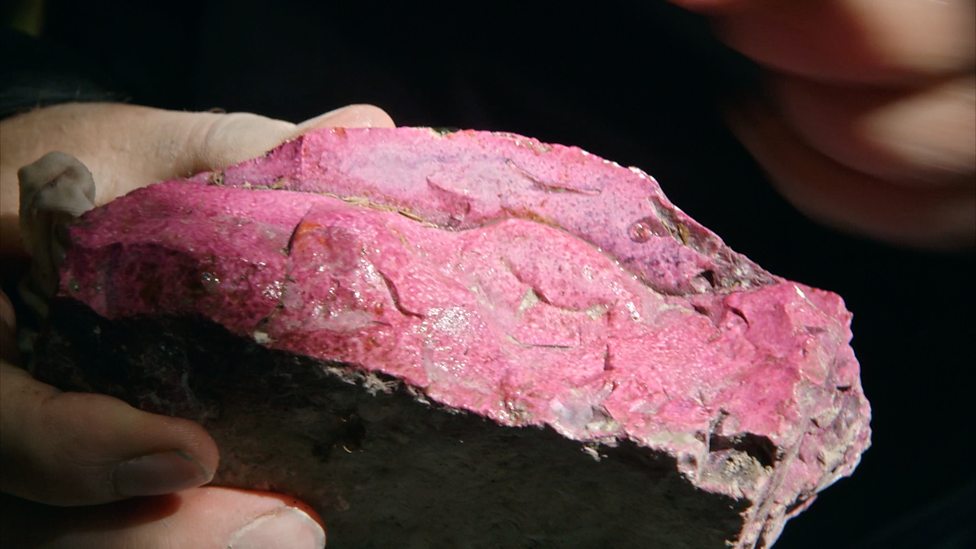
I considered posting this in another Sto-nenge thread earlier today, but thought that an interesting tit-bit may be lost there... though UK readers may already be aware of this, it having been featured in a BBC documentary recently - it can also be watched via YT in case location is a factor:
Relevant section begins at 14 mins:
So we know the importance of a supply of good tool-stone to most early cultures. It was traded over significant distances - beautiful banded flint from Poland was imported to the UK during the Neolithic for example.. here is a modern example of this gorgeous stone:
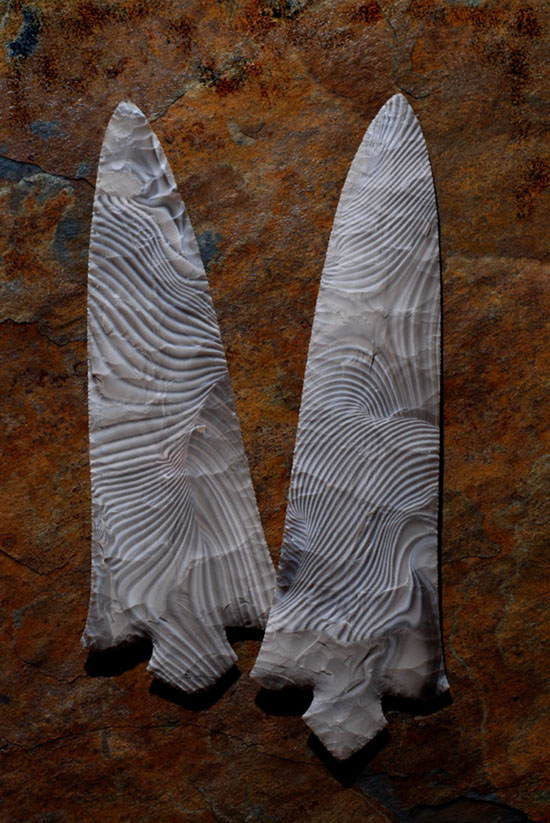
Rather magnificent, especially when compared to the usually mottled blacks, greys and whites of British flint.
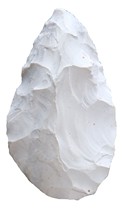
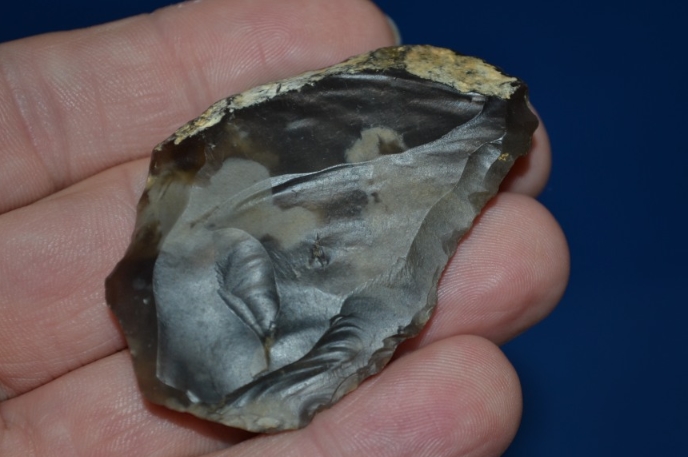
One could easily suggest that possession of a vivid pink coloured flint source could be of considerable prestige and even mystique. Superb for making items that transcended the merely practical?
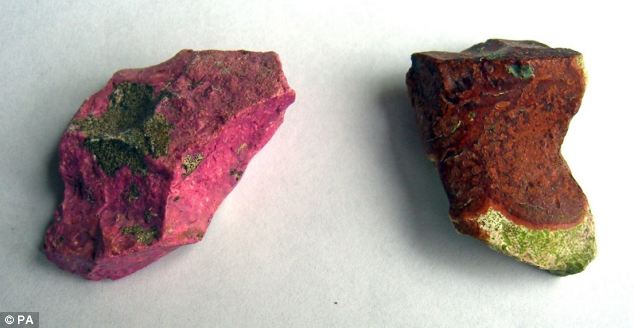
Source
Sadly, there are no finds of pink blades so far, no doubt as the effect wears off after several thousand years underground. Perhaps in the future we can look forwards to existing finds being tested for traces of the Algae that causes the discolouration?
Obviously, i'm going to have to acquire some of this stuff myself - and if i ever do (it aint so far away from me, i just have to find a good water source) i shall knapp an arrowhead or two and post them here
Maybe these played a role?

I considered posting this in another Sto-nenge thread earlier today, but thought that an interesting tit-bit may be lost there... though UK readers may already be aware of this, it having been featured in a BBC documentary recently - it can also be watched via YT in case location is a factor:
Relevant section begins at 14 mins:
So we know the importance of a supply of good tool-stone to most early cultures. It was traded over significant distances - beautiful banded flint from Poland was imported to the UK during the Neolithic for example.. here is a modern example of this gorgeous stone:

Rather magnificent, especially when compared to the usually mottled blacks, greys and whites of British flint.


One could easily suggest that possession of a vivid pink coloured flint source could be of considerable prestige and even mystique. Superb for making items that transcended the merely practical?

Another possible reason why people were attracted to the area was the striking bright pink colouring of the flint, which isn’t that colour anywhere else in the country.”
“The colouring is caused by algae – Hildenbrandia rivularis – and it is due to a combination of dappled light and the unusually warm spring water in the area – 10 to 15 degrees.
It transforms a normal looking flint placed in spring water into a bright pink one after the flint has been taken out of the water for about 5 hours. Mr Jacques added: “It is a rather magical effect now and may well have been seen so then.”
Source
Sadly, there are no finds of pink blades so far, no doubt as the effect wears off after several thousand years underground. Perhaps in the future we can look forwards to existing finds being tested for traces of the Algae that causes the discolouration?
Obviously, i'm going to have to acquire some of this stuff myself - and if i ever do (it aint so far away from me, i just have to find a good water source) i shall knapp an arrowhead or two and post them here
Wow nice find. One of my fav colors, pink. This is a wonderful little surprise about Stonehenge.
I am going to watch the full video a bit later today when the kids have settled down a bit and i can take a breather.
The only thing I can add is a description of some of the the symbolisms of magenta:
Symbolism of Magenta
leolady
I am going to watch the full video a bit later today when the kids have settled down a bit and i can take a breather.
The only thing I can add is a description of some of the the symbolisms of magenta:
In addition, the 'Color Symbolism of Magenta' stretches to divinity, love, learning, & nurturing. It can assist people with earthly skills, in fusing with powerful spirituality, and in releasing the past agony & moving forward. The color cleanses a being emotionally and infuses the feeling of self-respect, protection, and self-awareness in self. This color balances emotions by being simultaneously cheering and soothing, thereby controlling over emotional and under emotional conditions. Definitely, despite the complexity of its tones and shading, magenta is a brilliant, versatile color, creating all the magic possible through artistry or otherwise. Article Source: EzineArticles.com...
Symbolism of Magenta
leolady
Awesomeness! I too, would want a piece, and be on the look out for a nice algae pond to soak in!
Flag and star for any old Stone-age examples, boos and tossed vegetables for any modern points being passed off as stone-age (I know that the OP
doesn't do this, but it is so prevalent in the points collecting field that it makes me want to cry stone tears).
a reply to: leolady
Thanks for commenting, i'm not so big on the various mystical correlations of planets, colours, plants and so forth but these kinds of finds are great for speculations. Something has to be at the roots of how people made such connections way back in prehistory and who knows, this may be one of those causes?
a reply to: EA006
A nice idea, and while it's the chalk that produces the white colouring in the various hill figures it is possible that "pinked" flint could have been used to further the impact of these monuments.
Very cool piece of speculation
a reply to: ladyinwaiting
Once you fracture the surface of a flint coloured in this way you would reveal the previous natural colour, and it seems that one could simply take existing tools and dip them in the required waters and watch them change colour. It would have to make such a water source extremely valuable. I really need to spend a couple of days in Wiltshire after the winter and try to find such a pool.
Thanks for commenting, i'm not so big on the various mystical correlations of planets, colours, plants and so forth but these kinds of finds are great for speculations. Something has to be at the roots of how people made such connections way back in prehistory and who knows, this may be one of those causes?
a reply to: EA006
A nice idea, and while it's the chalk that produces the white colouring in the various hill figures it is possible that "pinked" flint could have been used to further the impact of these monuments.
Very cool piece of speculation
a reply to: ladyinwaiting
Once you fracture the surface of a flint coloured in this way you would reveal the previous natural colour, and it seems that one could simply take existing tools and dip them in the required waters and watch them change colour. It would have to make such a water source extremely valuable. I really need to spend a couple of days in Wiltshire after the winter and try to find such a pool.
Pink is the sacred color associated with the heart. One use a pink stone like a rose quarts or
pink turmalite to heal the heart
chakra. Earth's heart chakra is in Glastonbury, Somerset, and Shaftesbury. Stonehenge
is located in Glastonbury. The ancient may have buried the pink stone at Stonehenge in order to heal the earth's heart chakra or in reverence.
-MM
-MM
edit on 21-12-2014 by MerkabaMeditation because: (no reason given)
I wonder if the womenfolk who used flint knives liked the pink color in much the same way the womenfolk now like brightly colored mobile phone cases?
Thought you might like this info.
newsok.com...
I grew up here. Ten Acre Rock is where the stone is queried from.
a reply to: leolady
newsok.com...
I grew up here. Ten Acre Rock is where the stone is queried from.
a reply to: leolady
edit on 21-12-2014 by ttropia because: (no reason given)
originally posted by: MerkabaMeditation
Pink is the sacred color associated with the heart. One use a pink stone like a rose quarts to heal the heart chakra. Earth's heart chakra is in Glastonbury, Somerset, and Shaftesbury. Stonehenge is located in Glastonbury. The ancient may have buried the pink stone at Stonehenge to heal the earth's heart chakra.
-MM
Stonehenge is about 50 miles from Glastonbury fyi, Salisbury is the nearest decent sized town. It's highly questionable whether anyone from Ancient Briton would have had contact with proto-Hindu ideas etc about 6000 years ago, though similar ideas/cosmology ofc could have arisen in Britain at the time (and they share an ancient lineage and linguistic roots) but we'll never know.
I often find the overlaying of Eastern spirituality/mythology on ancient Europe as somewhat troubling and unneccessarily new-age to be honest. I'm not saying it's entirely invalid (i'm a lover of monomyth etc), but native Britain has it's own flavour, and i find myself irrationally annoyed when my vision of it is coloured all foreign!
originally posted by: skalla
Stonehenge is about 50 miles from Glastonbury fyi, Salisbury is the nearest decent sized town.
Shaftesbury is 27 miles by road from Stonehenge and about 20 miles by air.
originally posted by: skalla
It's highly questionable whether anyone from Ancient Briton would have had contact with proto-Hindu ideas etc about 6000 years ago, though similar ideas/cosmology ofc could have arisen in Britain at the time (and they share an ancient lineage and linguistic roots) but we'll never know.
Even though Stonehenge may be 6,000 years old there is no proof that the pink stones were buried at that time, or have I missed something? They may have been buried at a later date. Also, there are suggestions that at one time there was a one-world religion, namely shamanism - and that religions like hinduism came from this influence; thus they may have had the same common ideas about chakras or energy centers.
-MM
edit on 21-12-2014 by MerkabaMeditation because: (no reason given)
edit on 21-12-2014 by MerkabaMeditation because: (no reason
given)
a reply to: MerkabaMeditation
Yeah, Shaftesbury is still a good day's walk from Salisbury. Any ideas of AB's using/believing in a Chakra system is very speculative, and nothing wrong with that.
I'm just banging on about a pet hate of mine where a more modern rendition of Hinduism (ie not the pre-vedic of the era of Stonehenge's construction) is used as a filter to interpret something on the other side of the globe.
I just don't see the point.
ETA: sorry, replied before your edit, i'll be back after food
Yeah, Shaftesbury is still a good day's walk from Salisbury. Any ideas of AB's using/believing in a Chakra system is very speculative, and nothing wrong with that.
I'm just banging on about a pet hate of mine where a more modern rendition of Hinduism (ie not the pre-vedic of the era of Stonehenge's construction) is used as a filter to interpret something on the other side of the globe.
I just don't see the point.
ETA: sorry, replied before your edit, i'll be back after food
edit on 21-12-2014 by skalla because: (no reason given)
originally posted by: skalla
a reply to: MerkabaMeditation
Yeah, Shaftesbury is still a good day's walk from Salisbury.
It's a 7 hour 40 minute walk from Shaftesbury to Stonehenge, not a whole day. Or a 32 minute drive with a car.
-MM
edit on 21-12-2014 by MerkabaMeditation because: (no reason given)
edit on 21-12-2014 by MerkabaMeditation because: (no
reason given)
originally posted by: MerkabaMeditation
originally posted by: skalla
a reply to: MerkabaMeditation
Yeah, Shaftesbury is still a good day's walk from Salisbury.
It's a 7 hour 40 minute walk from Shaftesbury to Stonehenge, not a day.
-MM
"A day's walk" is a phrase that i assumed you would understand.
At a non hurried pace, over hills etc and stopping for for a meal, and with enough time to break camp and arrive in time for a cup of PG tips, it's a day's walk. Not everyone yomps 80 miles a day with a bergen yunno
a reply to: stormcell
I can imagine them having pink tinged arrow tips. I'm being serious too. I wonder if someone were hit with one of these pink tipped pieces of flint that was formed into an arrow would it cause someone to get sick if it were to get into their blood ?
I wonder if the algae that caused this pink coloration on the rock was used in another way besides for aesthetic purposes, could there be medicinal properties to its use or could they have discovered that the algae helped to keep the water clean ? I don't know if this particular algae has any of those properties or characteristics.
Anyways, after watching the video it looks like they were probably mining this flint rock in abundance, the question is what were all the uses besides weapons and tools.
leolady
I can imagine them having pink tinged arrow tips. I'm being serious too. I wonder if someone were hit with one of these pink tipped pieces of flint that was formed into an arrow would it cause someone to get sick if it were to get into their blood ?
I wonder if the algae that caused this pink coloration on the rock was used in another way besides for aesthetic purposes, could there be medicinal properties to its use or could they have discovered that the algae helped to keep the water clean ? I don't know if this particular algae has any of those properties or characteristics.
Anyways, after watching the video it looks like they were probably mining this flint rock in abundance, the question is what were all the uses besides weapons and tools.
leolady
originally posted by: MerkabaMeditation
Even though Stonehenge may be 6,000 years old there is no proof that the pink stones were buried at that time, or have I missed something? They may have been buried at a later date. Also, there are suggestions that at one time there was a one-world religion, namely shamanism - and that religions like hinduism came from this influence; thus they may have had the same common ideas about chakras or energy centers.
-MM
Unless i missed something too, these pinked flints were not ritually buried as far as we know - indeed there is no suggestion that excavated flints have been tested for this algae and no worked pink flint has been found - the effect does not last thousands of years presumably. It's just that immersing flints in the right pools will make them turn pink.
a reply to: leolady
In all honesty the local flint is not special, it's just discoloured by Algae on the outside due to the water, temps etc.
It's still just any old flint really, and when mined (pits and galleries were typical) i highly doubt it was pink, as it would be embedded in the mother chalk with none of the water, sunlight and warmth required. The pools were the magic factor, as such.
I imagine it was discovered by taking a rock out of a pool, and it may well work on other rocks too, not just flints.
In all honesty the local flint is not special, it's just discoloured by Algae on the outside due to the water, temps etc.
It's still just any old flint really, and when mined (pits and galleries were typical) i highly doubt it was pink, as it would be embedded in the mother chalk with none of the water, sunlight and warmth required. The pools were the magic factor, as such.
I imagine it was discovered by taking a rock out of a pool, and it may well work on other rocks too, not just flints.
a reply to: leolady
I would absolutely pimp my stone-age gear with pink tipped blades and points! Peeps have always used prettier stone when available, even if it was just for sunday-best. For recent examples we can look at the various pretty stones that were still being used and exchanged by Native Americans not much more than a century ago.
It would be interesting to know how dangerous a wound from such a point would be. I'm taking a guess at not immediately any worse, but possibly a major infection risk?
I would absolutely pimp my stone-age gear with pink tipped blades and points! Peeps have always used prettier stone when available, even if it was just for sunday-best. For recent examples we can look at the various pretty stones that were still being used and exchanged by Native Americans not much more than a century ago.
It would be interesting to know how dangerous a wound from such a point would be. I'm taking a guess at not immediately any worse, but possibly a major infection risk?
originally posted by: MerkabaMeditation
Pink is the sacred color associated with the heart. One use a pink stone like a rose quarts or pink turmalite to heal the heart chakra. Earth's heart chakra is in Glastonbury, Somerset, and Shaftesbury. Stonehenge is located in Glastonbury. The ancient may have buried the pink stone at Stonehenge in order to heal the earth's heart chakra or in reverence.
-MM
Interesting link re: The Glastonbury Zodiac - i first came across that idea through the Slaine stories in 2000AD many years ago and i really should see what else there is on the net nowadays, such as illustrated maps and so forth - it would make a great thread, maybe you should write it up?
edit on 21-12-2014 by
skalla because: typo
new topics
-
The BEAST System of Revelation has been awoken and has assumed control, at least since COVID.
New World Order: 49 minutes ago -
The Department of Justice Spies on Congress with Google Assisting.
Political Conspiracies: 6 hours ago -
HOUSE VOTES 320-91 TO BAN CHRISTIAN BELIEFS IN AMERICA
Political Issues: 11 hours ago
top topics
-
Thousands of Anti-Semitic People Protest Israel's government in Tel Aviv
Middle East Issues: 14 hours ago, 12 flags -
Dugin's interview and the West's complete ignorance of Russia
New World Order: 13 hours ago, 10 flags -
HOUSE VOTES 320-91 TO BAN CHRISTIAN BELIEFS IN AMERICA
Political Issues: 11 hours ago, 9 flags -
The Department of Justice Spies on Congress with Google Assisting.
Political Conspiracies: 6 hours ago, 7 flags -
The BEAST System of Revelation has been awoken and has assumed control, at least since COVID.
New World Order: 49 minutes ago, 0 flags
active topics
-
Motive for the alleged assault on Blasey Ford. Conservatives should see this.
General Conspiracies • 26 • : Zanti Misfit -
UN Estimates Rebuilding Gaza Will Cost Up To 40 Billion Dollars
Middle East Issues • 129 • : jofafot -
Farmers jailed without due process
General Conspiracies • 26 • : grey580 -
US drug control agency will move to reclassify marijuana in a historic shift, AP sources say
Breaking Alternative News • 75 • : confuzedcitizen -
V.P. Biden's Cure Cancer Project Was Successful - President Biden Says Cancer is Now Eradicated.
Medical Issues & Conspiracies • 27 • : Croton -
HOUSE VOTES 320-91 TO BAN CHRISTIAN BELIEFS IN AMERICA
Political Issues • 56 • : DBCowboy -
Zionists of ATS assemble
Political Issues • 176 • : cherokeetroy -
New whistleblower Jason Sands speaks on Twitter Spaces last night.
Aliens and UFOs • 107 • : introufo2 -
Gov Kristi Noem Shot and Killed "Less Than Worthless Dog" and a 'Smelly Goat
2024 Elections • 168 • : Sookiechacha -
Thousands of Anti-Semitic People Protest Israel's government in Tel Aviv
Middle East Issues • 69 • : jofafot
19
